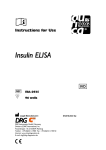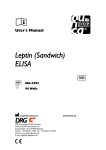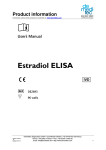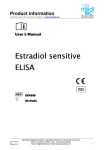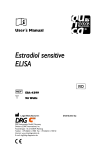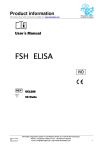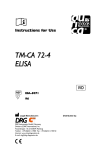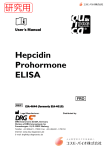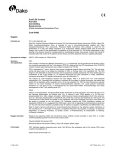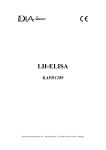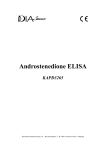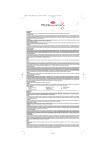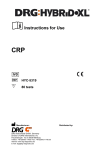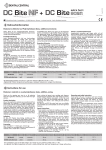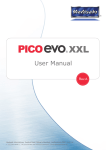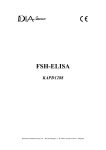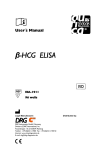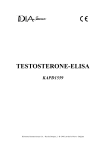Download DE2935 Insulin ELISA 141030 m
Transcript
Product information Information about other products is available at: www.demeditec.com Userś Manual Insulin ELISA DE2935 96 wells Version 08-07/14 JS Updated 141030 Demeditec Diagnostics GmbH • Lise-Meitner-Straße 2 • D-24145 Kiel (Germany) Phone: +49 (0)431/71922-0 • Fax. +49 (0)431/71922-55 Email: [email protected] • http://www.demeditec.com 1 Demeditec Insulin ELISA DE2935 Contents / Inhaltsverzeichnis / Contenuti / Contenido / Contenu 1 2 3 4 5 6 7 8 9 10 11 12 INTRODUCTION ...............................................................................................................................3 PRINCIPLE OF THE TEST ...............................................................................................................3 WARNINGS AND PRECAUTIONS ...................................................................................................4 REAGENTS .......................................................................................................................................5 SPECIMEN COLLECTION AND PREPARATION ............................................................................6 ASSAY PROCEDURE ......................................................................................................................6 EXPECTED NORMAL VALUES ......................................................................................................8 QUALITY CONTROL ........................................................................................................................8 PERFORMANCE CHARACTERISTICS ...........................................................................................8 LIMITATIONS OF USE ...................................................................................................................10 LEGAL ASPECTS ...........................................................................................................................10 REFERENCES / LITERATURE ......................................................................................................11 1 2 3 4 5 6 7 8 9 10 11 12 EINLEITUNG ...................................................................................................................................12 TESTPRINZIP .................................................................................................................................12 VORSICHTSMAßNAHMEN ............................................................................................................12 BESTANDTEILE DES KITS ............................................................................................................13 PROBENVORBEREITUNG ............................................................................................................14 TESTDURCHFÜHRUNG ................................................................................................................14 ERWARTETE WERTE ....................................................................................................................16 QUALITÄTS-KONTROLLE .............................................................................................................16 ASSAY CHARACTERISTIKA..........................................................................................................16 GRENZEN DES TESTS ..................................................................................................................17 RECHTLICHE GRUNDLAGEN .......................................................................................................17 REFERENZEN / LITERATUR .........................................................................................................17 1 2 3 4 5 6 7 8 9 10 11 12 INTRODUCCIÓN ............................................................................................................................18 FUNDAMENTO DEL ENSAYO .......................................................................................................18 PRECAUCIONES ............................................................................................................................18 COMPONENTES DEL KIT..............................................................................................................19 MUESTRAS.....................................................................................................................................20 PROCEDIMIENTO DE ENSAYO ....................................................................................................20 VALORES ESPERADOS ................................................................................................................22 CONTROL DE CALIDAD ................................................................................................................22 CARACTERÍSTICAS DEL ENSAYO ..............................................................................................22 LIMITACIONES DE USO ................................................................................................................23 ASPECTOS LEGALES ...................................................................................................................23 REFERENCIAS / BIBLIOGRAFÍA ...................................................................................................23 SYMBOLS USED WITH DEMEDITEC ELISAS .....................................................................................24 Version 08-07/14 JS Updated 141030 Demeditec Diagnostics GmbH • Lise-Meitner-Straße 2 • D-24145 Kiel (Germany) Phone: +49 (0)431/71922-0 • Fax. +49 (0)431/71922-55 Email: [email protected] • http://www.demeditec.com 2 Demeditec Insulin ELISA DE2935 1 INTRODUCTION 1.1 Intended Use The DEMEDITEC Insulin ELISA is an enzyme immunoassay for the quantitative in vitro diagnostic measurement of Insulin in serum and plasma 1.2 Summary and Explanation Insulin is the principal hormone responsible for the control of glucose metabolism. It is synthesized in the β-cells of the islets of Langerhans as the precursor, proinsulin, which is processed to form Cpeptide and insulin. Both are secreted in equimolar amounts into the portal circulation. The mature insulin molecule comprises two polypeptide chains, the A chain and B chain (21 and 30 amino acids respectively). The two chains are linked together by two inter-chain disulphide bridges. There is also an intra-chain disulphide bridge in the A chain. Secretion of insulin is mainly controlled by plasma glucose concentration, and the hormone has a number of important metabolic actions. Its principal function is to control the uptake and utilisation of glucose in peripheral tissues via the glucose transporter. This and other hypoglycaemic activities, such as the inhibition of hepatic gluconeogenesis and glycogenolysis are counteracted by the hyperglycaemic hormones including glucagon, epinephrine (adrenaline), growth hormone and cortisol. Insulin concentrations are severely reduced in insulin-dependent diabetes mellitus (IDDM) and some other conditions such as hypopituitarism. Insulin levels are raised in non-insulin-dependent diabetes mellitus (NIDDM), obesity, insulinoma and some endocrine dysfunctions such as Cushing’s syndrome and acromegaly. 2 PRINCIPLE OF THE TEST The DEMEDITEC Insulin ELISA Kit is a solid phase enzyme-linked immunosorbent assay (ELISA) based on the sandwich principle. The microtiter wells are coated with a monoclonal antibody directed towards a unique antigenic site on the Insulin molecule. An aliquot of patient sample containing endogenous Insulin is incubated in the coated well with enzyme conjugate, which is an anti-Insulin antibody conjugated with Biotin. After incubation the unbound conjugate is washed off. During the second incubation step Streptavidin Peroxidase Enzyme Complex binds to the biotin-antiInsulin antibody. The amount of bound HRP complex is proportional to the concentration of Insulin in the sample. Having added the substrate solution, the intensity of colour developed is proportional to the concentration of Insulin in the patient sample. Version 08-07/14 JS Updated 141030 Demeditec Diagnostics GmbH • Lise-Meitner-Straße 2 • D-24145 Kiel (Germany) Phone: +49 (0)431/71922-0 • Fax. +49 (0)431/71922-55 Email: [email protected] • http://www.demeditec.com 3 Demeditec Insulin ELISA DE2935 3 WARNINGS AND PRECAUTIONS 1. This kit is for in vitro diagnostic use only. For professional use only. 2. All reagents of this test kit which contain human serum or plasma have been tested and confirmed negative for HIV I/II, HBsAg and HCV by FDA approved procedures. All reagents, however, should be treated as potential biohazards in use and for disposal. 3. Before starting the assay, read the instructions completely and carefully. Use the valid version of instructions for use provided with the kit. Be sure that everything is understood. 4. The microplate contains snap-off strips. Unused wells must be stored at 2 °C to 8 °C in the sealed foil pouch and used in the frame provided. 5. Pipetting of samples and reagents must be done as quickly as possible and in the same sequence for each step. 6. Use reservoirs only for single reagents. This especially applies to the substrate reservoirs. Using a reservoir for dispensing a substrate solution that had previously been used for the conjugate solution may turn solution coloured. Do not pour reagents back into vials as reagent contamination may occur. 7. Mix the contents of the microplate wells thoroughly to ensure good test results. Do not reuse microwells. 8. Do not let wells dry during assay; add reagents immediately after completing the rinsing steps. 9. Allow the reagents to reach room temperature (21 °C - 26 °C) before starting the test. Temperature will affect the absorbance readings of the assay. However, values for the patient samples will not be affected. 10. Never pipet by mouth and avoid contact of reagents and specimens with skin and mucous membranes. 11. Do not smoke, eat, drink or apply cosmetics in areas where specimens or kit reagents are handled. 12. Wear disposable latex gloves when handling specimens and reagents. Microbial contamination of reagents or specimens may give false results. 13. Handling should be done in accordance with the procedures defined by an appropriate national biohazard safety guideline or regulation. 14. Do not use reagents beyond expiry date as shown on the kit labels. 15. All indicated volumes have to be performed according to the protocol. Optimal test results are only obtained when using calibrated pipettes and microtiter plate readers. 16. Do not mix or use components from kits with different lot numbers. It is advised not to exchange wells of different plates even of the same lot. The kits may have been shipped or stored under different conditions and the binding characteristics of the plates may result slightly different. 17. Avoid contact with Stop Solution containing 1 N acidic solution. It may cause skin irritation and burns. 18. Some reagents contain Proclin 300, BND and/or MIT as preservatives. In case of contact with eyes or skin, flush immediately with water. 19. TMB substrate has an irritant effect on skin and mucosa. In case of possible contact, wash eyes with an abundant volume of water and skin with soap and abundant water. Wash contaminated objects before reusing them. If inhaled, take the person to open air. 20. Chemicals and prepared or used reagents have to be treated as hazardous waste according to the national biohazard safety guideline or regulation. 21. For information on hazardous substances included in the kit please refer to Safety Data Sheets. Safety Data Sheets for this product are available upon request directly from DEMEDITEC. Version 08-07/14 JS Updated 141030 Demeditec Diagnostics GmbH • Lise-Meitner-Straße 2 • D-24145 Kiel (Germany) Phone: +49 (0)431/71922-0 • Fax. +49 (0)431/71922-55 Email: [email protected] • http://www.demeditec.com 4 Demeditec Insulin ELISA DE2935 4 REAGENTS 4.1 Reagents provided 1. Microtiterwells, 12 x 8 (break apart) strips, 96 wells; Wells coated with anti-Insulin antibody (monoclonal). 2. Zero Standard, 1 vial, 3 mL, ready to use; 0 µIU/mL, Contains non-mercury preservative. 3. Standard (Standard 1-5), 5 vials, 1 mL, ready to use; Concentrations: 6.25 - 12.5 – 25 - 50 and 100 µIU/mL, Conversion: µIU/mL x 0.0433 = ng/mL, ng/mL x 23.09 = µIU/mL The standards are calibrated against international WHO approved Reference material NIBSC 66/304.; Contain non-mercury preservative. 4. Enzyme Conjugate, 1 vial, 5 mL, ready to use, mouse monoclonal anti-Insulin conjugated to biotin; Contains non-mercury preservative. 5. Enzyme Complex, 1 vial, 7 mL, ready to use, Streptavidin-HRP Complex; Contains non-mercury preservative. 6. Substrate Solution, 1 vial, 14 mL, ready to use, Tetramethylbenzidine (TMB). 7. Stop Solution, 1 vial, 14 mL, ready to use, contains 1 N acidic solution, Avoid contact with the stop solution. It may cause skin irritations and burns. 8. Wash Solution, 1 vial, 30 mL (40X concentrated), see „Preparation of Reagents“. Note: Additional Zero Standard for sample dilution is available upon request. 4.2 − − − − − − Materials required but not provided A microtiter plate calibrated reader (450 ± 10 nm) Calibrated variable precision micropipettes. Absorbent paper. Distilled or deionised water Timer Graph paper or software for data reduction 4.3 Storage Conditions When stored at 2 °C to 8 °C unopened reagents will retain reactivity until expiration date. Do not use reagents beyond this date. Opened reagents must be stored at 2 °C to 8 °C. Microtiter wells must be stored at 2 °C to 8 °C. Once the foil bag has been opened, care should be taken to close it tightly again. Opened kits retain activity for 8 weeks if stored as described above. 4.4 Reagent Preparation Bring all reagents and required number of strips to room temperature prior to use. Wash Solution Add deionized water to the 40X concentrated Wash Solution. Dilute 30 mL of concentrated Wash Solution with 1170 mL deionized water to a final volume of 1200 mL. The diluted Wash Solution is stable for 2 weeks at room temperature. 4.5 Disposal of the Kit The disposal of the kit must be made according to the national regulations. Special information for this product is given in the Safety Data Sheet. 4.6 Damaged Test Kits In case of any severe damage to the test kit or components, DEMEDITEC has to be informed in writing, at the latest, one week after receiving the kit. Severely damaged single components should not be used for a test run. They have to be stored until a final solution has been found. After this, they should be disposed according to the official regulations. Version 08-07/14 JS Updated 141030 Demeditec Diagnostics GmbH • Lise-Meitner-Straße 2 • D-24145 Kiel (Germany) Phone: +49 (0)431/71922-0 • Fax. +49 (0)431/71922-55 Email: [email protected] • http://www.demeditec.com 5 Demeditec Insulin ELISA DE2935 5 SPECIMEN COLLECTION AND PREPARATION Serum or plasma (only heparin- or citrate plasma) can be used in this assay. Do not use haemolytic, icteric or lipaemic specimens. Please note: Samples containing sodium azide should not be used in the assay. 5.1 Specimen Collection Serum: Collect blood by venipuncture (e.g. Sarstedt Monovette for serum), allow to clot, and separate serum by centrifugation at room temperature. Do not centrifuge before complete clotting has occurred. Patients receiving anticoagulant therapy may require increased clotting time. Plasma: Whole blood should be collected into centrifuge tubes containing anti-coagulant (e.g. Sarstedt Monovette with the appropriate plasma preparation) and centrifuged immediately after collection. 5.2 Specimen Storage and Preparation Specimens should be capped and may be stored for up to 5 days at 2 °C to 8 °C prior to assaying. Specimens held for a longer time (at least one year) should be frozen only once at -20 °C prior to assay. Thawed samples should be inverted several times prior to testing. 5.3 Specimen Dilution If in an initial assay, a specimen is found to contain more than the highest standard, the specimens can be diluted with Zero Standard and re-assayed as described in Assay Procedure. For the calculation of the concentrations this dilution factor has to be taken into account. Example: a) dilution 1:10: b) dilution 1:100: 6 6.1 10 µL sample + 90 µL Zero Standard (mix thoroughly) 10 µL dilution a) 1:10 + 90 µL Zero Standard (mix thoroughly). ASSAY PROCEDURE General Remarks − All reagents and specimens must be allowed to come to room temperature before use. All reagents must be mixed without foaming. − Once the test has been started, all steps should be completed without interruption. − Use new disposal plastic pipette tips for each standard, control or sample in order to avoid cross contamination. − Absorbance is a function of the incubation time and temperature. Before starting the assay, it is recommended that all reagents are ready, caps removed, all needed wells secured in holder, etc. This will ensure equal elapsed time for each pipetting step without interruption. − As a general rule the enzymatic reaction is linearly proportional to time and temperature. Version 08-07/14 JS Updated 141030 Demeditec Diagnostics GmbH • Lise-Meitner-Straße 2 • D-24145 Kiel (Germany) Phone: +49 (0)431/71922-0 • Fax. +49 (0)431/71922-55 Email: [email protected] • http://www.demeditec.com 6 Demeditec Insulin ELISA DE2935 6.2 Test Procedure Each run must include a standard curve. 1. Secure the desired number of Microtiter wells in the frame holder. 2. Dispense 25 µL of each Standard, control and samples with new disposable tips into appropriate wells. 3. Dispense 25 µL Enzyme Conjugate into each well. Thoroughly mix for 10 seconds. It is important to have a complete mixing in this step. 4. Incubate for 30 minutes at room temperature. 5. Briskly shake out the contents of the wells. Rinse the wells 3 times with diluted Wash Solution (400 µL per well). Strike the wells sharply on absorbent paper to remove residual droplets. Important note: The sensitivity and precision of this assay is markedly influenced by the correct performance of the washing procedure! 6. Add 50 µL of Enzyme Complex to each well. 7. Incubate for 30 minutes at room temperature. 8. Briskly shake out the contents of the wells. Rinse the wells 3 times with diluted Wash Solution (400 µL per well). Strike the wells sharply on absorbent paper to remove residual droplets. 9. Add 50 µL of Substrate Solution to each well. 10. Incubate for 15 minutes at room temperature. 11. Stop the enzymatic reaction by adding 50 µL of Stop Solution to each well. 12. Determine the absorbance (OD) of each well at 450 ± 10 nm with a microtiter plate reader. It is recommended that the wells be read within 10 minutes after adding the Stop Solution. 6.3 Calculation of Results 1. Calculate the average absorbance values for each set of standards, controls and patient samples. 2. Using linear graph paper, construct a standard curve by plotting the mean absorbance obtained from each standard against its concentration with absorbance value on the vertical (Y) axis and concentration on the horizontal (X) axis. 3. Using the mean absorbance value for each sample determine the corresponding concentration from the standard curve. 4. Automated method: The results in the Instructions for Use have been calculated automatically using a 4-Parameter curve fit. (4 Parameter Rodbard or 4 Parameter Marquardt are the preferred methods.) Other data reduction functions may give slightly different results. 5. The concentration of the samples can be read directly from this standard curve. Samples with concentrations higher than that of the highest standard have to be further diluted or reported as > 100 µIU/mL. For the calculation of the concentrations this dilution factor has to be taken into account. 6.3.1 Example of Typical Standard Curve The following data is for demonstration only and cannot be used in place of data generations at the time of assay. Version 08-07/14 JS Updated 141030 Standard Optical Units (450 nm) Standard 0 (0 µIU/mL) 0.03 Standard 1 (6.25 µIU/mL) 0.07 Standard 2 (12.5 µIU/mL) 0.14 Standard 3 (25 µIU/mL) 0.35 Standard 4 (50 µIU/mL) 0.88 Standard 5 (100 µIU/mL) 2.05 Demeditec Diagnostics GmbH • Lise-Meitner-Straße 2 • D-24145 Kiel (Germany) Phone: +49 (0)431/71922-0 • Fax. +49 (0)431/71922-55 Email: [email protected] • http://www.demeditec.com 7 Demeditec Insulin ELISA DE2935 7 EXPECTED NORMAL VALUES It is strongly recommended that each laboratory should determine its own normal and abnormal values. In a study conducted with apparently normal healthy adults, using the DEMEDITEC Insulin ELISA the following values are observed: 2 µIU/mL to 25 µIU/mL The results alone should not be the only reason for any therapeutic consequences. The results should be correlated to other clinical observations and diagnostic tests. 8 QUALITY CONTROL Good laboratory practice requires that controls be run with each calibration curve. A statistically significant number of controls should be assayed to establish mean values and acceptable ranges to assure proper performance. It is recommended to use control samples according to state and federal regulations. The use of control samples is advised to assure the day to day validity of results. Use controls at both normal and pathological levels. The controls and the corresponding results of the QCLaboratory are stated in the QC certificate added to the kit. The values and ranges stated on the QC sheet always refer to the current kit lot and should be used for direct comparison of the results. It is also recommended to make use of national or international Quality Assessment programs in order to ensure the accuracy of the results. Employ appropriate statistical methods for analysing control values and trends. If the results of the assay do not fit to the established acceptable ranges of control materials patient results should be considered invalid. In this case, please check the following technical areas: Pipetting and timing devices; photometer, expiration dates of reagents, storage and incubation conditions, aspiration and washing methods. After checking the above mentioned items without finding any error contact your distributor or DEMEDITEC directly. 9 PERFORMANCE CHARACTERISTICS 9.1 Assay Dynamic Range The range of the assay is between 1.76 – 100 µIU/mL. 9.2 Specificity of Antibodies (Cross Reactivity) The cross reactivities were determinated by addition of different analytes to serum containing 4 ng/mL (≅ 100 µIU/mL) Insulin and measuring the apparent Insulin concentration. Added analyte to a high value serum (4 ng/mL) Porcine Insulin Bovine Insulin Dog Insulin Rabbit Insulin Rat Insulin Human Proinsulin Porcine Proinsulin Bovine Proinsulin 8 ng/mL 8 ng/mL 16 ng/mL 16 ng/mL 16 ng/mL 32 ng/mL 16 ng/mL 16 ng/mL Observed Insulin value (ng/mL) Cross reaction (%) 17 17.8 17.2 14.1 4.0 4.1 4.0 4.1 > 100 > 100 82 63 0 0 0 0 9.3 Sensitivity The analytical sensitivity of the DEMEDITEC ELISA was calculated by adding 2 standard deviations to the mean of 20 replicate analyses of the Zero Standard and was found to be 1.76 µIU/mL. Version 08-07/14 JS Updated 141030 Demeditec Diagnostics GmbH • Lise-Meitner-Straße 2 • D-24145 Kiel (Germany) Phone: +49 (0)431/71922-0 • Fax. +49 (0)431/71922-55 Email: [email protected] • http://www.demeditec.com 8 Demeditec Insulin ELISA DE2935 9.4 Reproducibility 9.4.1 Intra-Assay The within assay variability is shown below: Sample n Mean (µIU/mL) CV (%) 1 20 17.5 2.6 2 20 66.4 1.8 9.4.2 Inter-Assay The between assay variability is shown below: Sample n Mean (µIU/mL) CV (%) 1 12 17.4 2.9 2 12 66.9 6.0 9.5 Recovery Samples have been spiked by adding Insulin solutions with known concentrations in a 1:1 ratio. The expected values were calculated by addition of half of the values determined for the undiluted samples and half of the values of the known solutions. The % Recovery has been calculated by multiplication of the ratio of the measurements and the expected values with 100. Sample Added Concentration 1:1 (v/v) (µIU/mL) Measured Conc. (µIU/mL) Expected Conc. (µIU/mL) Recovery (%) 21.2 1 100 66.4 60.6 109.6 50 38.8 35.6 108.9 25 23.4 23.1 101.1 12.5 17.37 16.9 102.9 69.0 2 9.6 100 84.6 84.5 100.1 50 58.4 59.5 98.1 25 43.2 47.0 91.8 12.5 37.5 40.8 91.9 Linearity Sample 1 2 Version 08-07/14 JS Updated 141030 Dilution Measured Conc. (µIU/mL) Expected Conc. (µIU/mL) Recovery (%) None 21.2 21.2 1:2 9.4 10.6 88.5 1:4 5.2 5.3 98.5 1:8 2.8 2.7 105.9 1:16 1.5 1.3 110.3 None 69.0 69.0 1:2 30.5 34.5 88.4 1:4 17.6 17.3 102.0 1:8 8.7 8.6 101.2 1:16 4.8 4.3 110.4 Demeditec Diagnostics GmbH • Lise-Meitner-Straße 2 • D-24145 Kiel (Germany) Phone: +49 (0)431/71922-0 • Fax. +49 (0)431/71922-55 Email: [email protected] • http://www.demeditec.com 9 Demeditec Insulin ELISA DE2935 10 LIMITATIONS OF USE Reliable and reproducible results will be obtained when the assay procedure is performed with a complete understanding of the package insert instruction and with adherence to good laboratory practice. Any improper handling of samples or modification of this test might influence the results. 10.1 Interfering Substances Haemoglobin (up to 4 mg/mL), bilirubin (up to 0.5 mg/mL) and triglyceride (up to 30 mg/mL) have no influence on the assay results. 10.2 Drug Interferences Until today no substances (drugs) are known to us, which have an influence to the measurement of Insulin in a sample. 10.3 High-Dose-Hook Effect No hook effect was observed in this test up to 1600 µIU/mL of Insulin. 11 LEGAL ASPECTS 11.1 Reliability of Results The test must be performed exactly as per the manufacturer’s instructions for use. Moreover the user must strictly adhere to the rules of GLP (Good Laboratory Practice) or other applicable national standards and/or laws. This is especially relevant for the use of control reagents. It is important to always include, within the test procedure, a sufficient number of controls for validating the accuracy and precision of the test. The test results are valid only if all controls are within the specified ranges and if all other test parameters are also within the given assay specifications. In case of any doubt or concern please contact DEMEDITEC. 11.2 Therapeutic Consequences Therapeutic consequences should never be based on laboratory results alone even if all test results are in agreement with the items as stated under point 11.1. Any laboratory result is only a part of the total clinical picture of a patient. Only in cases where the laboratory results are in acceptable agreement with the overall clinical picture of the patient should therapeutic consequences be derived. The test result itself should never be the sole determinant for deriving any therapeutic consequences. 11.3 Liability Any modification of the test kit and/or exchange or mixture of any components of different lots from one test kit to another could negatively affect the intended results and validity of the overall test. Such modification and/or exchanges invalidate any claim for replacement. Claims submitted due to customer misinterpretation of laboratory results subject to point 11.2. are also invalid. Regardless, in the event of any claim, the manufacturer’s liability is not to exceed the value of the test kit. Any damage caused to the test kit during transportation is not subject to the liability of the manufacturer. Version 08-07/14 JS Updated 141030 Demeditec Diagnostics GmbH • Lise-Meitner-Straße 2 • D-24145 Kiel (Germany) Phone: +49 (0)431/71922-0 • Fax. +49 (0)431/71922-55 Email: [email protected] • http://www.demeditec.com 10 Demeditec Insulin ELISA DE2935 12 REFERENCES / LITERATURE 1. Flier, J. S., Kahn. C. R. and Roth, J. (1979). Receptors, antireceptor antibodies and mechanisms of insulin resistance; N. Engl. J. Med., 300, 8, 413-419. 2. Frier, B. M., Ashby, J. P., Nairn, I. M. and Bairs, J.D. (1981). Plasma insulin, C-peptide and glucagon concentrations in patients with insulin-independent diabetes treated with chlorpropamide. Diab. metab., 7,1, 45-49. 3. Judzewitsch, R. G., Pfeifer, M. A., Best, J. D., Beard J. C., Halter, J. B. and Porte D. Jr. (1982). Chronic Chlorpropamide therapy of noninsulin-dependent diabetes augments basal and stimulated insulin secretion by increasing islet sensitivity to glucose. J. Clin. End. and Metab. 55, 2, 321328. 4. Kosaka, K., Hagura, R. and Kuzuya, T. (1977). Insulin responses in equivocal and definite diabetes, with special reference to subjects who had mild glucose intolerance but later developed definite diabetes. Diabetes 26, 10, 944-952. 5. Starr, J. Il, Mako, M. E., Juhn, D. and Rubenstein, A. H. (1978). Measurement of serum proinsulin-like material: cross-reacitivity of porcine and human proinsulin in the insulin radioimmunoassay, J. Lab. Clin. Med. 91,4, 691-692. Version 08-07/14 JS Updated 141030 Demeditec Diagnostics GmbH • Lise-Meitner-Straße 2 • D-24145 Kiel (Germany) Phone: +49 (0)431/71922-0 • Fax. +49 (0)431/71922-55 Email: [email protected] • http://www.demeditec.com 11 Demeditec Insulin ELISA DE2935 1 EINLEITUNG Der DEMEDITEC Insulin ELISA wird zur quantitativen Bestimmung von Insulin in Serum und Plasma eingesetzt. Nur für In-vitro Diagnostik. 2 TESTPRINZIP Der DEMEDITEC Insulin ELISA ist ein Festphasen-Enzymimmunoassay, der auf der Sandwichtechnik basiert. Die Wells der Mikrotiterplatten sind mit einem monoklonalen Antikörper beschichtet, der gegen eine definierte Antikörper-Bindungsstelle des Insulin -Moleküls gerichtet ist. Die Proben werden in die beschichteten Wells gegeben und mit einem Enzym-Konjugat inkubiert. Das Konjugat enthält einen anti-Insulin-Antikörper, der mit Biotin konjugiert ist. Das nicht gebundene Konjugat wird durch Waschen der Wells entfernt. In einer zweiten Inkubation bindet ein Streptavidin-Peroxidase-Enzymkomplex an den biotinylierten anti-Insulin-Antikörper. Nach einem weiteren Waschschritt wird die Substratlösung zugegeben und die Farbentwicklung nach einer definierten Zeit gestoppt. Die Intensität der gebildeten Farbe ist proportional der Insulin-Konzentration in der Probe. Die Extinktion wird bei 450 nm mit einem Mikrotiterplattenleser gemessen. 3 VORSICHTSMAßNAHMEN − Dieser Kit ist nur zum in vitro diagnostischen Gebrauch geeignet. − Nur die gültige, im Testkit enthaltene, Gebrauchsanweisung verwenden. − Informationen zu im Kit enthaltenen gefährlichen Substanzen entnehmen Sie bitte dem Sicherheitsdatenblatt. − Alle Bestandteile dieses Testkits, die humanes Serum oder Plasma enthalten, wurden mit FDAgeprüften Methoden auf HIV I/II, HbsAg und HCV getestet und als negativ bestätigt. Jedoch sollten alle Bestandteile im Umgang und bei der Entsorgung wie mögliche Gefahrenstoffe betrachtet werden. − Der Kontakt mit der Stop Solution sollte vermieden werden, da sie 1 N saure Lösung enthält. Saure Lösung kann Hautreizungen und Verbrennungen verursachen. − Nicht mit dem Mund pipettieren und den Kontakt von Kitbestandteilen und Proben mit Haut und Schleimhäuten vermeiden. − In den Bereichen, in denen Proben oder Kitbestandteile verwendet werden, nicht rauchen, essen oder Kosmetika verwenden. − Beim Umgang mit Proben oder Reagenzien Einweg-Latexhandschuhe tragen. Die Verunreinigung von Reagenzien oder Proben mit Mikroben kann zu falschen Ergebnissen führen. − Der Gebrauch sollte gemäß der Vorschriften einer entsprechenden nationalen GefahrenstoffSicherheitsrichtlinie erfolgen. − Reagenzien nicht nach dem auf dem Kit-Etikett angegebenen Verfallsdatum verwenden. − Alle im Kit-Protokoll angegebenen Mengen müssen genau eingehalten werden. Optimale Ergebnisse können nur durch Verwendung kalibrierter Pipetten und Mikrotiterplatten-Lesegeräte erreicht werden. − Komponenten von Kits mit unterschiedlichen Lotnummern nicht untereinander vertauschen. Es wird empfohlen, keine Wells von verschiedenen Platten zu verwenden, auch nicht, wenn es sich um das gleiche Lot handelt. Die Kits können unter anderen Bedingungen gelagert oder versendet worden sein, so dass die Bindungscharakteristik der Platten leicht unterschiedlich ausfällt. − Chemikalien und zubereitete oder bereits benutzte Reagenzien müssen gemäß den nationalen Gefahrenstoffvorschriften wie gefährlicher Abfall behandelt werden. − Sicherheitsdatenblätter für dieses Produkt sind auf Anfrage direkt von der Firma Demeditec Diagnostics GmbH erhältlich. Version 08-07/14 JS Updated 141030 Demeditec Diagnostics GmbH • Lise-Meitner-Straße 2 • D-24145 Kiel (Germany) Phone: +49 (0)431/71922-0 • Fax. +49 (0)431/71922-55 Email: [email protected] • http://www.demeditec.com 12 Demeditec Insulin ELISA DE2935 4 BESTANDTEILE DES KITS 4.1 Kitinhalt 1. Microtiterwells, 96 Wells, 12 x 8 Wells (einzeln brechbar); Mit anti- Insulin-Antikörper (monoklonal) beschichtet. 2. Zero Standard, 1 Fläschchen, 3 mL, gebrauchsfertig, 0 µIU/mL; Enthält quecksilberfreies Konservierungsmittel. 3. Standard (Standard 1-5), 5 Fläschchen, je 1 mL, gebrauchsfertig; Konzentrationen: 6,25 – 12,5 – 25 - 50 - 100 µIU/mL Umrechnungsfaktor: µIU/mL x 0.0433 = ng/mL, ng/mL x 23.09 = µIU/mL Die Standards sind kalibriert gegen das Internationale WHO-Referenzmaterial NIBSC 66/304. Enthält quecksilberfreies Konservierungsmittel. 4. Enzyme Conjugate (Enzymkonjugat), 1 Fläschchen, 5 mL, gebrauchsfertig; monoklonaler MausAnti-Insulin-Antikörper mit Biotin konjugiert. Enthält quecksilberfreies Konservierungsmittel. 5. Enzyme Complex (Enzymkomplex), 1 Fläschchen, 7 mL, gebrauchsfertig; Streptavidin HRPKomplex. Enthält quecksilberfreies Konservierungsmittel. 6. Substrate Solution (Substratlsg.), 1 Fläschchen, 14 mL, gebrauchsfertig; Substratlösung TMB. 7. Stop Solution (Stopplösung), 1 Fläschchen, 14 mL, gebrauchsfertig; enthält 1 N saure Lösung, Kontakt mit der Stopplösung vermeiden! Kann Hautreizungen und Verbrennungen verursachen. 8. Wash Solution (Waschlsg.), 1 Fläschchen, 30 mL, 40X konz.; S. „Vorbereitung der Reagenzien“. Anmerkung: Zusätzlicher Zero Standard zur Probenverdünnung ist auf Anfrage erhältlich. 4.2 − − − − Erforderliche aber nicht enthaltene Geräte und Materialien Kalibriertes Mikrotiterplattenlesegerät mit 450 ± 10 nm Filter) Kalibrierte variable Präzisions-Mikropipette Saugfähiges Papier Destilliertes Wasser 4.3 Lagerung und Haltbarkeit des Kits Die ungeöffneten Reagenzien behalten bei Lagerung um 2-8 °C ihre Reaktivität bis zum Verfallsdatum. Nach dem Verfallsdatum die Reagenzien nicht mehr verwenden. Nach dem Öffnen sollten alle Reagenzien bei 2-8 °C gelagert werden. Die Mikrotiterwells sollten bei 2-8 °C gelagert werden. Der einmal geöffnete Folienbeutel sollte stets sehr sorgfältig wieder verschlossen werden. Unter den beschriebenen Lagerbedingungen behalten geöffnete Kits 8 Wochen ihre Reaktivität. 4.4 Vorbereitung der Reagenzien Alle Reagenzien sowie die benötigte Anzahl von Wells sollen vor dem Gebrauch auf Raumtemperatur gebracht werden. Wash Solution Die 40-fach konzentrierte Wash Solution (30 mL) mit 1170 mL destilliertem Wasser auf ein Gesamtvolumen von 1200 mL verdünnen. Die verdünnte Waschlösung ist bei Raumtemperatur für 2 Wochen stabil. 4.5 Entsorgung des Kits Die Entsorgung des Kits muss gemäß den nationalen gesetzlichen Vorschriften erfolgen. Spezielle Informationen für dieses Produkt finden Sie im Sicherheitsdatenblatt, Kapitel 13. 4.6 Beschädigte Testkits Im Falle einer starken Beschädigung des Testkits oder der Komponenten muss DEMEDITEC in schriftlicher Form spätestens eine Woche nach Erhalt des Kits informiert werden. Stark beschädigte Einzelkomponenten sollten nicht für den Testlauf verwendet werden. Sie müssen gelagert werden bis eine endgültige Lösung gefunden wurde. Danach sollten Sie gemäß den offiziellen Richtlinien entsorgt werden. Version 08-07/14 JS Updated 141030 Demeditec Diagnostics GmbH • Lise-Meitner-Straße 2 • D-24145 Kiel (Germany) Phone: +49 (0)431/71922-0 • Fax. +49 (0)431/71922-55 Email: [email protected] • http://www.demeditec.com 13 Demeditec Insulin ELISA DE2935 5 PROBENVORBEREITUNG Serum oder Plasma (Heparin- oder Zitratplasma) kann in diesem Test als Probenmaterial eingesetzt werden. Lipämische, ikterische und/oder stark hämolysierte Proben sollten nicht verwendet werden. Achtung: Proben, die Natriumazid enthalten, sollten nicht verwendet werden. 5.1 Probenentnahme Serum: Blut durch Venenpunktion entnehmen (z.B. mit Sarstedt Monovette für Serum), gerinnen lassen und das Serum durch Zentrifugation bei Raumtemperatur abtrennen. Vor der Zentrifugation muss die Gerinnung vollständig abgeschlossen sein. Bei Patienten, die Antikoagulantien erhalten, kann die Gerinnungszeit länger dauern. Plasma: Die Blutentnahme erfolgt mit Röhrchen, die ein Antikoagulanz enthalten (z.B.: Sarstedt Monovette – mit entsprechender Plasma-Präparierung). Das Plasma wird als Überstand nach einer Zentrifugation gewonnen. 5.2 Probenaufbewahrung Proben sollten stets gut verschlossen sein und können vor Testbeginn bis zu 5 Tage bei 2 °C bis 8 °C gelagert werden. Für eine längere Aufbewahrung (mindestens 1 Jahr) sollten die Proben eingefroren bei -20 °C bis zum Testbeginn gelagert werden. Nur einmal einfrieren. Aufgetaute Proben sollten vor Testbeginn vorsichtig durchmischt werden, ohne Schaumbildung. 5.3 Probenverdünnung Wenn in einem ersten Testdurchlauf bei einer Probe eine Konzentration höher als der höchste Standard gefunden wird, kann diese Probe mit Zero Standard weiter verdünnt und nochmals bestimmt werden. Die Verdünnung muss jedoch bei der Berechnung der Konzentration beachtet werden. Beispiel: a) Verdünnung 1:10: 10 µL Serum + 90 µL Zero Standard gründlich mischen) b) Verdünnung 1:100: 10 µL Verdünnung a) 1:10 + 90 µL Zero Standard (gründlich mischen). 6 6.1 TESTDURCHFÜHRUNG Allgemeine Hinweise − Alle Reagenzien und Proben müssen vor Gebrauch auf Raumtemperatur gebracht und gut durchmischt werden. Dabei sollte Schaumbildung vermieden werden. − Wenn die Testdurchführung einmal begonnen wurde, muss sie ohne Unterbrechung zu Ende geführt werden. − Für jeden Standard, jede Kontrolle oder Probe eine neue Plastikspitze verwenden, um Verschleppungen zu vermeiden. − Die Optische Dichte ist abhängig von Inkubationszeit und Temperatur. Deshalb ist es notwendig, vor Beginn der Testdurchführung alle Reagenzien in einen arbeitsbereiten Zustand zu bringen, die Deckel der Fläschchen zu öffnen, alle benötigten Wells in den Halter zu setzen. Nur eine solche Vorbereitung garantiert gleiche Zeiten für jeden Pipettiervorgang ohne Pausen. − Als generelle Regel gilt, dass die enzymatische Reaktion linear proportional zu Zeit und Temperatur ist. Version 08-07/14 JS Updated 141030 Demeditec Diagnostics GmbH • Lise-Meitner-Straße 2 • D-24145 Kiel (Germany) Phone: +49 (0)431/71922-0 • Fax. +49 (0)431/71922-55 Email: [email protected] • http://www.demeditec.com 14 Demeditec Insulin ELISA DE2935 6.2 Testdurchführung Jeder Lauf muss eine Standardkurve beinhalten. 1. Die benötigte Anzahl Wells in der Halterung befestigen. 2. Je 25 µL Standard, Kontrollen und Proben mit neuen Plastikspitzen in die entsprechenden Wells geben. 3. 25 µL Enzyme Conjugate in jedes Well geben. Für 10 Sekunden gut schütteln. Es ist sehr wichtig, in diesem Schritt eine komplette Durchmischung zu erreichen. 4. 30 Minuten bei Raumtemperatur inkubieren. 5. Den Inhalt der Wells kräftig ausschütteln. Wells 3-mal mit verdünnter Wash Solution (400 µL) waschen. Verbleibende Flüssigkeit durch Ausklopfen der Wells auf saugfähigem Papier entfernen. Achtung: Die Sensitivität und Präzision dieses Assays wird erheblich beeinflusst von der korrekten Durchführung des Waschschrittes! 6. 50 µL Ezyme Complex in jedes Well geben. 7. 30 Minuten bei Raumtemperatur inkubieren. 8. Den Inhalt der Wells kräftig ausschütteln. Wells 3-mal mit verdünnter Wash Solution (400 µL) waschen. Verbleibende Flüssigkeit durch Ausklopfen der Wells auf saugfähigem Papier entfernen. 9. 50 µL Substrate Solution in jedes Well geben. 10. 15 Minuten bei Raumtemperatur inkubieren. 11. Die enzymatische Reaktion durch Zugabe von 50 µL Stop Solution in jedes Well abstoppen. 12. Die Optische Dichte bei 450 ± 10 nm mit einem Mikrotiterplatten-Lesegerät innerhalb von 10 Minuten nach Zugabe der Stop Solution bestimmen. 6.3 Ergebnisermittlung 1. Die durchschnittlichen Werte der Optischen Dichte (OD) für jedes Set von Standards, Kontrollen und Patientenproben bestimmen. 2. Eine Standardkurve ermitteln durch Auftragen der mittleren Optischen Dichte jedes Standards gegen die Konzentration, wobei der OD-Wert auf der vertikalen (Y) Achse und die Konzentration auf der horizontalen (X) Achse eingetragen wird. 3. Unter Verwendung der mittleren OD wird für jede Probe die entsprechende Konzentration aus der Standardkurve ermittelt. 4. Automatische Methode: Die in der Gebrauchsanweisung angegebenen Werte wurden automatisch mit Hilfe der 4 Parameter Gleichung bestimmt. (4 Parameter Rodbard oder 4 Parameter Marquardt sind die bevorzugten Methoden.) Andere Auswertungsfunktionen können leicht abweichende Werte ergeben. 5. Die Konzentration der Proben kann direkt von der Standardkurve abgelesen werden. Proben, die eine höhere Konzentration als die des höchsten Standards enthalten, müssen verdünnt werden. Dieser Verdünnungsfaktor muss bei der Berechnung der Konzentration beachtet werden. 6.3.1 Beispiel für eine Standardkurve Nachfolgend wird ein typisches Beispiel für eine Standardkurve mit dem DEMEDITEC ELISA gezeigt. Diese Werte sollten nicht zur Berechnung von Patientendaten verwendet werden. Standard Version 08-07/14 JS Updated 141030 Optische Dichte (450 nm) Standard 0 (0 µIU/mL) 0,03 Standard 1 (6.25 µIU/mL) 0,07 Standard 2 (12.5 µIU/mL) 0,14 Standard 3 (25 µIU/mL) 0,35 Standard 4 (50 µIU/mL) 0,88 Standard 5 (100 µIU/mL) 2,05 Demeditec Diagnostics GmbH • Lise-Meitner-Straße 2 • D-24145 Kiel (Germany) Phone: +49 (0)431/71922-0 • Fax. +49 (0)431/71922-55 Email: [email protected] • http://www.demeditec.com 15 Demeditec Insulin ELISA DE2935 7 ERWARTETE WERTE Es wird empfohlen, dass jedes Labor seine eigenen normalen und abnormalen Werte ermittelt. In einer Studie wurden die Proben von gesunden Erwachsenen untersucht. Dabei ergaben sich mit dem DEMEDITEC Insulin ELISA folgende Werte: 2 µIU/mL bis 25 µIU/mL 8 QUALITÄTS-KONTROLLE Es wird empfohlen, die Kontrollproben gemäß den nationalen gesetzlichen Bestimmungen einzusetzen. Durch die Verwendung von Kontrollproben wird eine Tag-zu-Tag Überprüfung der Ergebnisse erzielt. Es sollten Kontrollen sowohl mit normalem als auch pathologischem Level eingesetzt werden. Die Kontrollen mit den entsprechenden Ergebnissen des QC-Labors sind im QC-Zertifikat, das dem Kit beiliegt, aufgeführt. Die im QC-Blatt angegebenen Werte und Bereiche beziehen sich stets auf die aktuelle Kitcharge und sollten zum direkten Vergleich der Ergebnisse verwendet werden. Es wird ebenfalls empfohlen, an nationalen oder internationalen Qualitätssicherungs-Programmen teilzunehmen, um die Genauigkeit der Ergebnisse zu sichern. Es sollten geeignete statistische Methoden zur Analyse von Kontroll-Werten und Trends angewendet werden. Wenn die Ergebnisse des Assays nicht mit den angegebenen Akzeptanzbereichen des Kontrollmaterials übereinstimmen, sollten die Patientenergebnisse als ungültig eingestuft werden. In diesem Fall überprüfen Sie bitte die folgenden Bereiche: Pipetten und Zeitnehmer, Photometer, Verfallsdatum der Reagenzien, Lagerungs- und Inkubationsbedingungen, Absaug- und Waschmethode. Sollten Sie nach Überprüfung der vorgenannten Bereiche keinen Fehler erkannt haben, setzen Sie sich bitte mit Ihrem Lieferanten oder direkt mit der Firma DEMEDITEC in Verbindung. 9 ASSAY CHARACTERISTIKA 9.1 Messbereich Der Messbereich des Testes liegt zwischen 1,76 – 100 µIU/mL. 9.2 Spezifität der Antikörper (Kreuzreaktivität) Die Daten entnehmen Sie bitte der ausführlichen englischen Arbeitsanleitung. 9.3 Sensitivität Die analytische Sensitivität, definiert als Mittelwert plus der zweifachen Standardabweichung des Zero Standards (n = 20), beträgt 1,76 µIU/mL. Die Daten zu: 9.4 Reproduzierbarkeit (Präzision) 9.5 Wiederfindung 9.6 Linearität entnehmen Sie bitte der ausführlichen englischen Arbeitsanleitung. Version 08-07/14 JS Updated 141030 Demeditec Diagnostics GmbH • Lise-Meitner-Straße 2 • D-24145 Kiel (Germany) Phone: +49 (0)431/71922-0 • Fax. +49 (0)431/71922-55 Email: [email protected] • http://www.demeditec.com 16 Demeditec Insulin ELISA DE2935 10 GRENZEN DES TESTS Jede unsachgemäße Behandlung von Proben oder Modifikationen dieses Tests können die Ergebnisse beeinflussen. 10.1 Interferenzen Hämoglobin (bis zu 4 mg/mL), Bilirubin (bis zu 0.5 mg/mL) und Triglyceride (bis zu 30 mg/mL) haben keinen Einfluss auf das Testergebnis. 10.2 Beeinflussung durch Medikamente Uns sind bislang keine Stoffe (Medikamente) bekannt geworden, deren Einnahme die Messung des Insulin-Gehaltes der Probe beeinflussen würde. 10.3 High-Dose-Hook Effekt Ein Hook Effekt tritt bei Proben mit bis zu 1600 µIU/mL Insulin nicht auf. 11 RECHTLICHE GRUNDLAGEN 11.1 Zuverlässigkeit der Ergebnisse Der Test muss exakt gemäß der Testanleitung des Herstellers abgearbeitet werden. Darüber hinaus muss der Benutzer sich strikt an die Regeln der GLP (Good Laboratory Practice) oder andere eventuell anzuwendende Regeln oder nationale gesetzliche Vorgaben halten. Dies betrifft besonders den Gebrauch der Kontrollreagenzien. Es ist sehr wichtig, bei der Testdurchführung stets eine ausreichende Anzahl Kontrollen zur Überprüfung der Genauigkeit und Präzision mitlaufen zu lassen. Die Testergebnisse sind nur gültig, wenn alle Kontrollen in den vorgegebenen Bereichen liegen, und wenn alle anderen Testparameter die vorgegebenen Spezifikationen für diesen Assay erfüllen. Wenn Sie bezüglich eines Ergebnisses Zweifel oder Bedenken haben, setzen Sie sich bitte mit der Firma DEMEDITEC in Verbindung. 11.2 Therapeutische Konsequenzen Therapeutische Konsequenzen sollten keinesfalls nur aufgrund von Laborergebnissen erfolgen, selbst dann nicht, wenn alle Testergebnisse mit den in 11.1. genannten Voraussetzungen übereinstimmen. Jedes Laborergebnis ist nur ein Teil des klinischen Gesamtbildes eines Patienten. Nur in Fällen, in denen die Laborergebnisse in akzeptabler Übereinstimmung mit dem allgemeinen klinischen Bild des Patienten stehen, sollten therapeutische Konsequenzen eingeleitet werden. Das Testergebnis allein sollte niemals als alleinige Grundlage für die Einleitung therapeutischer Konsequenzen dienen. 11.3 Haftung Jegliche Veränderungen des Testkits und/oder Austausch oder Vermischung von Komponenten unterschiedlicher Chargen von einem Testkit zu einem anderen, können die gewünschten Ergebnisse und die Gültigkeit des gesamten Tests negativ beeinflussen. Solche Veränderungen und/oder Austausch haben den Ausschluss jeglicher Ersatzansprüche zur Folge. Reklamationen, die aufgrund von Falschinterpretation von Laborergebnissen durch den Kunden gemäß Punkt 11.2. erfolgen, sind ebenfalls abzuweisen. Im Falle jeglicher Reklamation ist die Haftung des Herstellers maximal auf den Wert des Testkits beschränkt. Jegliche Schäden, die während des Transports am Kit entstanden sind, unterliegen nicht der Haftung des Herstellers. 12 REFERENZEN / LITERATUR Angaben zu den Referenzen entnehmen Sie bitte der ausführlichen englischen Arbeitsanleitung. Version 08-07/14 JS Updated 141030 Demeditec Diagnostics GmbH • Lise-Meitner-Straße 2 • D-24145 Kiel (Germany) Phone: +49 (0)431/71922-0 • Fax. +49 (0)431/71922-55 Email: [email protected] • http://www.demeditec.com 17 Demeditec Insulin ELISA DE2935 1 INTRODUCCIÓN El Kit de inmunoensayo enzimático DEMEDITEC Insulin ELISA proporciona los materiales necesarios para la determinación cuantitativa de la insulina en suero y plasma. Este ensayo está diseñado solo para diagnóstico in vitro. 2 FUNDAMENTO DEL ENSAYO El Kit DEMEDITEC Insulin ELISA ELISA es un ensayo en fase sólida de inmunoadsorción unido a enzimas (ELISA), basado en el principio de sándwich. Los pocillos de las placas están recubiertos con un anticuerpo monoclonal dirigido contra un foci antigénico en la molécula inulina. Una aliquota de muestras de los pacientes contenido endógena insulina está incubado en un pocillo recubierto con enzima conjugado el cual es un anti-insulina anticuerpo conjugado con Biotin. Después de la incubación el conjugado no unido se lava. Durante el segundo paso de incubación Streptavidin Peroxidase Enzyme Complex se una con el biotin-anti-insulina anticuerpo. La cantidad del complejo HRP unido es proporcional a la concentración de insulina en la muestra. Después de la adición de la solución sustrato, la intensidad de color desarrollado es proporcional a la concentración de insulina en la muestra del paciente. 3 PRECAUCIONES − Este kit es solamente para diagnóstico in vitro. − Por favor, se usa solo la version valida de la metodico técnico incluido aqui en el kit. − Para obtener información de las sustancias peligrosas incluidas en el kit por favor mirar las hojas de los datos de seguridad del material. − Todos los reactivos en este kit de ensayo que contienen suero o plasma humano se han ensayado y confirmado ser negativos para HIV I/II, HBsAg y HCV mediante procedimientos aprobados por la FDA. Sin embargo, todos los reactivos deben ser tratados tanto en su uso como dispensación como potencialmente biopeligrosos. − Evitar contacto con Stop Solution que contiene 1 N acido solucion. Puede provocar irritación y quemaduras en la piel. − Nunca pipetear con la boca y evitar el contacto de los reactivos y las muestras con la piel y con membranas mucosas. − No fumar, comer, beber o usar cosméticos en áreas donde las muestras o los reactivos del kit están siendo usados. − Usar guantes de látex cuando se utilicen las muestras y los reactivos. La contaminación microbiana de los reactivos o las muestras puede dar resultados erróneos. − El manejo debe realizarse de acuerdo a los procedimientos definidos por las guías o regulación nacionales de seguridad de sustancias biopeligrosas. − No utilizar los reactivos después de su fecha de caducidad que aparece en las etiquetas del kit. − Todos los volúmenes indicados han de ser realizados de acuerdo con el protocolo. Los resultados óptimos del ensayo se obtienen solo cuando se utilizan pipetas y lectores de microplacas calibrados. − No mezclar o usar componentes de kits con distinto número de lote. Se recomienda no intercambiar pocillos de distintas placas incluso si son del mismo lote. Los kits pueden haber sido enviados o almacenados bajo diferentes condiciones y las características de unión de las placas pueden resultar diferentes. − Los compuestos químicos y los reactivos preparados o utilizados han de tratarse como residuos peligrosos de acuerdo con las guías o regulación nacionales de seguridad de sustancias biopeligrosas. − Las hojas de los datos de seguridad de este producto están disponibles bajo pedido directamente a Demeditec Diagnostics GmbH. Version 08-07/14 JS Updated 141030 Demeditec Diagnostics GmbH • Lise-Meitner-Straße 2 • D-24145 Kiel (Germany) Phone: +49 (0)431/71922-0 • Fax. +49 (0)431/71922-55 Email: [email protected] • http://www.demeditec.com 18 Demeditec Insulin ELISA DE2935 4 COMPONENTES DEL KIT 4.1 Componentes del Kit 1. Microtiterwells (Placas multipocillo), 12 x 8 tiras separables, 96 pocillos; Pocillos recubiertos con anticuerpo anti-insulina (monoclonal). 2. Zero Standard (Estándar), 1 vial, 3 mL listo para usar; 0 µlU/mL. Contiene conservantes sin mercurino. 3. Standard (Standard 1-5) (Estándar), 5 viales, 1 mL, listo para usar; Concentraciones: 6.25 - 12.5 – 25 - 50 and 100 µIU/mL, Conversión: µlU/mL x 0.0433 = ng/mL ng/mL x 23.09 = µlU/mL Los estándares están calibrados según autorizado WHO material de referéncia NIBSC 66/304; Contiene conservantes sin mercurino. 4. Enzyme Conjugate (Conjugado enzimático), 1 vial, 5 mL, listo para usar, Ratón monoclonal antiinsulina conjugado a biotina; Contiene conservante sin mercurio. 5. Enzyme Complex (Complejo enzimático), 1 vial, 7 mL, listo para usar, Estreptavidina-HRP complexo. Contiene conservante sin mercurio. 6. Substrate Solution (Solución de sustrato), 1 vial, 14 mL, listo para usar, Tetrametilbencidina (TMB). 7. Stop Solution (Solución de parada), 1 vial, 14 mL, listo para usar, contiene 1 N acido solucion, Evitar el contacto con la Solución de parada. Puede causar irritación y quemaduras en al piel. 8. Wash Solution (Solución de lavado), 1 vial, 30 mL (concentrado 40X), ver “Preparación de los Reactivos”. Nota: Se puede solicitar el Zero Standard para la dilución de la muestra. 4.2 − − − − Equipamiento y material requerido pero no provisto Lector de microplacas calibrado (450 ± 10 nm) Micropipetas de precisión variable calibradas. Papel absorbente. Agua destilada. 4.3 Almacenamiento y estabilidad del kit Cuando se almacena a 2-8 °C, los reactivos sin abrir mantienen su reactividad hasta la fecha de caducidad. No utilizar los reactivos más allá de esta fecha. Los reactivos abiertos han de almacenarse a 2-8 °C. Las placas multipocillo han de almacenarse a 2-8 °C. Una vez se ha abierto la bolsa hay que tener cuidado y cerrarla de nuevo. Los kits abiertos conservan su actividad durante 8 semanas si se almacenan como se ha descrito arriba. 4.4 Preparación de los Reactivos Dejar que todos los reactivos y el número requerido de tiras alcancen la temperatura ambiente antes de usarse. Wash Solution Añadir agua desionizada a la Solución de lavado concentraa 40x. Mezclar 30 mL de Wash Solution concentrada con 1170 mL de agua desionizada hasta un volumen final de 1200 mL. La solución del lavado diluida es estable durante 2 semanas a temperatura ambiente. 4.5 Eliminación del Kit La eliminación del kit debe realizarse de acuerdo con las leyes nacionales. En las hojas de datos de seguridad se proporciona información especial de este producto (ver capítulo 13). 4.6 Kits de ensayo dañados En caso de que exista cualquier daño severo del kit de ensayo o de sus componentes, ha de informarse por escrito a DEMEDITEC, no mas tarde de una semana después de recibir el kit. No deben utilizarse componentes dañados para llevar a cabo un ensayo. Han de almacenarse hasta que se encuentre una solución. Después de esto, deben ser eliminados de acuerdo con las leyes oficiales. Version 08-07/14 JS Updated 141030 Demeditec Diagnostics GmbH • Lise-Meitner-Straße 2 • D-24145 Kiel (Germany) Phone: +49 (0)431/71922-0 • Fax. +49 (0)431/71922-55 Email: [email protected] • http://www.demeditec.com 19 Demeditec Insulin ELISA DE2935 5 MUESTRAS En este ensayo pueden usarse suero o plasma (solo Heparina o citrato). No usar muestras hemolíticas, ictéricas o lipémicas. Tener en cuenta: No deben usarse muestras que contengan acida sódica. 5.1 Toma de muestras Suero: Recoger la sangre por punción en la vena (ej. Sarstedt Monovette para el suero), permitir coagulación, y separar el suero por centrifugación a temperatura ambiente. No centrifugar antes de la coagulación completa. Las muestras de pacientes que reciben terapia anticoagulante requieren más tiempo para coagular. Plasma: Toda la sangre ha de recogerse en tubos de centrífuga que contengan anticoagulante (Ej. Sarstedt Monovette con una preparación adecuada para el plasma) y centrifugar inmediatamente tras la recogida. 5.2 Almacenamiento de las muestras Las muestras deben ser tapadas y pueden ser almacenadas hasta 5 días a 2 °C a 8 °C antes del ensayo. Las muestras almacenadas por un período de tiempo mas largo (al menos un año) han de congelarse sólo una vez a -20 °C antes del ensayo. Las muestras descongeladas deben invertirse varias veces antes del ensayo. 5.3 Dilución de las muestras Si en un ensayo inicial, se encuentra una muestra que presenta valores mayores que el estándar mas concentrado, ha de diluirse con Zero Standard y volver a ensayarse como se describe en el Procedimiento de Ensayo. Para el cálculo de las concentraciones habrá que tener en cuenta el factor de dilución. Ejemplo: a) dilución 1:10: b) dilución 1:100: 6 6.1 10 µL muestra + 90 µL Zero Standard (mezclar totalmente) 10 µL dilución a) 1:10 + 90 µL Zero Standard (mezclar totalmente). PROCEDIMIENTO DE ENSAYO Consideraciones generales − Todos los reactivos y muestras han de estar a temperatura ambiente antes de su uso. Todos los reactivos deben mezclarse sin formar espuma. − Una vez se ha comenzado el ensayo deben completarse todos los pasos sin interrupción. − Utilizar puntas de pipeta de plástico nuevas para cada estándar, control o muestra para evitar combinaciones cruzadas. − La absorbancia es función del tiempo de incubación y la temperatura. Antes de comenzar el ensayo, se recomienda que todos los reactivos estén preparados, tapas removidas, todos los pocillos que se necesiten asegurados en recipiente, etc. Esto asegurará un tiempo similar para cada paso de pipeteo sin que haya interrupciones. − Como regla general, la reacción enzimática es linealmente proporcional al tiempo y a la temperatura. Version 08-07/14 JS Updated 141030 Demeditec Diagnostics GmbH • Lise-Meitner-Straße 2 • D-24145 Kiel (Germany) Phone: +49 (0)431/71922-0 • Fax. +49 (0)431/71922-55 Email: [email protected] • http://www.demeditec.com 20 Demeditec Insulin ELISA DE2935 6.2 Procedimiento de ensayo Cada uno debe incluir una curva de estándares. 1. Asegurar el número deseado de pocillos en el recipiente. 2. Dispensar 25 µL de cada Standard, Control y muestras con puntas nuevas en los pocillos adecuados. 3. Dispensar 25 µL de Enzyme Conjugate a cada pocillo. Mezclar totalmente durante 10 segundos. Es importante mezclar completamente en este paso. 4. Incubar durante 30 minutes a temperatura ambiente. 5. Sacudir enérgicamente el contenido de los pocillos. Lavar los pocillos 3 veces con Wash Solution diluida (400 µL por pocillo). Realizar un golpe seco de los pocillos contra el papel absorbente para eliminar las gotas residuales. Nota importante: La sensibilidad y la precisión de este ensayo se ve marcadamente influenciada por la realización correcta del proceso de lavado! 6. Adicionar 50 µL de Enzyme Complex a cada pocillo. 7. Incubar durante 30 minutes a temperatura ambiente. 8. Sacudir enérgicamente el contenido de los pocillos. Lavar los pocillos 3 veces con Wash Solution diluida (400 µL por pocillo). Realizar un golpe seco de los pocillos contra el papel absorbente para eliminar las gotas residuales. 9. Adicionar 50 µL de Substrate Solution a cada pocillo. 10. Incubar durante 15 minutes a temperatura ambiente. 11. Parar la reacción enzimática mediante la adición de 50 µL de Stop Solution a cada pocillo. 12. Leer la OD a 450 ± 10 nm con un lector de microplacas dentro de los 10 minutos después de la adición de la Stop Solution. 6.3 Cálculo de los Resultados 9. Calcular los valores de absorbancia media para cada conjunto de estándares, controles y muestras de pacientes. 10. Construir una curva estándar mediante la representación de la absorbancia media obtenida para cada estándar frente a su concentración con el valor de absorbancia en el eje vertical (Y) y la concentración en el eje horizontal (X). 11. Usando el valor de absorbancia media de cada muestra determinar la concentración correspondiente a partir de la curva estándar. 12. Método automatizado: Los resultados en las instrucciones de uso se han calculado automáticamente usando una curva de regresión 4 Parámetros. (4 Parámetros Rodbard o 4 Parámetros Marquardt son los métodos preferidos.) Otras funciones de regresión darán lugar a resultados sensiblemente diferentes. 13. La concentración de las muestras puede leerse directamente de la curva de estándares. Las muestras con concentraciones superiores al mayor estándar han de diluirse. Para el cálculo de las concentraciones hay que tener en cuenta el factor de dilución. 6.3.1 Ejemplo de una Curva Estándar Típica Los siguientes datos son solamente para la explicación y no pueden ser utilizados en lugar de los datos generados en el momento del ensayo. Estándar Version 08-07/14 JS Updated 141030 Unidades Ópticas (450 nm) Estándar 0 ( 0 µlU/mL) 0,03 Estándar 1 ( 6.25 µlU/mL) 0,07 Estándar 2 ( 12.5 µlU/mL) 0,14 Estándar 3 ( 25 µlU/mL) 0,35 Estándar 4 ( 50 µlU/mL) 0,88 Estándar 5 (100 µlU/mL) 2,05 Demeditec Diagnostics GmbH • Lise-Meitner-Straße 2 • D-24145 Kiel (Germany) Phone: +49 (0)431/71922-0 • Fax. +49 (0)431/71922-55 Email: [email protected] • http://www.demeditec.com 21 Demeditec Insulin ELISA DE2935 7 VALORES ESPERADOS Se recomienda encarecidamente que cada laboratorio determine sus valores normales e inusuales. En un estudio con adultos aparentemente sanos utilizando el DEMEDITEC Insulin ELISA se observaron los siguientes valores: 2 µlU/mL a 25 µlU/mL Solo los resultados no deberían ser el razón único para cualquier consecuencia terapéutica. Los resultados deberían corresponder con otras observaciones clínicas y ensayos diagnósticos. 8 CONTROL DE CALIDAD Se recomienda usar muestras control de acuerdo con las leyes estatales y federales. El uso de muestras control se recomienda para asegurar la validez diaria de los resultados. Usar controles tanto a niveles normal como patológico. Los controles y los correspondientes resultados del Laboratorio de control de calidad están fijados en el certificado de control de calidad que acompañan al kit. Los valores y los rangos fijados en la hoja del control de calidad se refieren siempre al kit actual y deben usarse para la comparación directa de los resultados. Es recomendable también hacer uso de programas de Aseguramiento de la Calidad nacionales o internacionales para asegurar la exactitud de los resultados. Utilizar métodos estadísticos apropiados para el análisis de los valores y tendencia de los controles. Si los resultados del ensayo no se ajustan a los rangos aceptables establecidos en los controles, los resultados obtenidos de los pacientes han de considerarse inválidos. En este caso, por favor comprobar las siguientes áreas técnicas: Pipeteo y tiempo empleado, fotómetro, fecha de caducidad de los reactivos, condiciones de almacenamiento e incubación, métodos de aspiración y lavado. Después de comprobar los asuntos arriba mencionado sin encontrar ningún error, contactar con su distribuidor o con DEMEDITEC directamente. 9 CARACTERÍSTICAS DEL ENSAYO 9.1 Rango dinámico del ensayo El rango del ensayo se encuentra entre 1,76 – 100 µIU/mL. 9.2 Especificidad de los Anticuerpos (Reactividad Cruzada) Consultar el manual de usuario en inglés. 9.3 Sensibilidad Analítica La sensibilidad analítica de los ELISA DEMEDITEC se calculó con añadir 2 desviaciones estándar de la media de veinte (20) réplicas del Estándar 0 y resultó ser 1,76 µIU/mL. 9.4 Precisión Consultar el manual de usuario en inglés. 9.5 Recuperación Consultar el manual de usuario en inglés. 9.6 Linealidad Consultar el manual de usuario en inglés. Version 08-07/14 JS Updated 141030 Demeditec Diagnostics GmbH • Lise-Meitner-Straße 2 • D-24145 Kiel (Germany) Phone: +49 (0)431/71922-0 • Fax. +49 (0)431/71922-55 Email: [email protected] • http://www.demeditec.com 22 Demeditec Insulin ELISA DE2935 10 LIMITACIONES DE USO Cualquier manipulación inadecuada de las muestras o modificaciones del ensayo pueden influenciar los resultados. 10.1 Sustancias que pueden interferir Hemoglobina (hasta 4 mg/mL), Bilirrubina (hasta 0.5 mg/mL) y Triglicéridos (hasta 30 mg/mL) no influencian los resultados del ensayo. 10.2 Interferencias con drogas Hasta ahora no se han encontrado sustancias (drogas) conocidas por nosotros, que tengan influencia en la medida de insulina en una muestra. 10.3 Efecto Gancho-Dosis-Elevada No se ha observado efecto gancho en este ensayo hasta 1600 µIU/mL de insulina. 11 ASPECTOS LEGALES 11.1 Fiabilidad de los Resultados El ensayo debe realizarse exactamente de acuerdo a las instrucciones del fabricante. Mas aún, el usuario debe ajustarse estrictamente a las reglas BPL (Buenas Prácticas de Laboratorio) o a otros estándares y/o leyes nacionales aplicables. Esto es especialmente relevante para el uso de reactivos control. Es importante incluir siempre, dentro del procedimiento de ensayo, un número suficiente de controles para validar la exactitud y la precisión del ensayo. Los resultados del ensayo son válidos sólo si todos los controles se encuentran dentro de los rangos especificados y si todos los otros parámetros del ensayo se encuentran dentro de las especificaciones dadas para el ensayo. En cado de alguna duda o inquietud, por favor, contactar con DEMEDITEC. 11.2 Consecuencias Terapéuticas Las consecuencias terapéuticas nunca deben basarse sólo en los resultados de laboratorio incluso si todos los resultados del ensayo están de acuerdo con los asuntos fijados en el punto 11.1. Cualquier resultado de laboratorio es solamente una parte del cuadro clínico de un paciente. Solamente en los casos donde los resultados de laboratorio están en acuerdo con todo el cuadro clínico de un paciente, se pueden derivar consecuencias terapéuticas. Nunca deben derivarse consecuencias terapéuticas a partir de solamente el resultado obtenido en el ensayo 11.3 Responsabilidad Cualquier modificación del kit y/o cambio o mezcla de cualquier componente procedentes de kits de lotes diferentes puede afectar negativamente a los resultados esperados y en la validez de todo el test. Esas modificaciones y/o cambios invalidad cualquier reclamación de reposición. Las reclamaciones emitidas debidas a una mala interpretación de los resultados de laboratorio por parte del comprador referidos al punto 11.2 son también inválidas. A pesar de todo, en el caso de cualquier reclamación, la responsabilidad del fabricante no excede el valor del kit. Cualquier daño provocado al kit durante su transporte no está sujeto a la responsabilidad del fabricante. 12 REFERENCIAS / BIBLIOGRAFÍA Consultar el manual de usuario en inglés. Version 08-07/14 JS Updated 141030 Demeditec Diagnostics GmbH • Lise-Meitner-Straße 2 • D-24145 Kiel (Germany) Phone: +49 (0)431/71922-0 • Fax. +49 (0)431/71922-55 Email: [email protected] • http://www.demeditec.com 23 Demeditec Insulin ELISA DE2935 SYMBOLS USED WITH DEMEDITEC ELISAS Symbol English Deutsch Français Español Italiano European Conformity CE-Konformitätskennzeichnung Conforme aux normes européennes Conformidad europea Conformità europea Consult instructions for use Gebrauchsanweisung beachten Consulter les instructions d’utilisation Consulte las Instrucciones Consultare le istruzioni per l’uso In vitro diagnostic device In-vitro-Diagnostikum Usage Diagnostic in vitro Para uso Diagnóstico in vitro Per uso Diagnostica in vitro For research use only Nur für Forschungszwecke Seulement dans le cadre de recherches Sólo para uso en investigación Solo a scopo di ricerca Catalogue number Katalog-Nr. Référence Número de catálogo No. di Cat. Lot. No. / Batch code Chargen-Nr. No. de lot Número de lote Lotto no Contains sufficient for <n> tests/ Ausreichend für ”n” Ansätze Contenu suffisant pour ”n” tests Contenido suficiente para <n> ensayos Contenuto sufficiente per ”n” saggi Storage Temperature Lagerungstemperatur Température de conservation Temperatura de conservacion Temperatura di conservazione Expiration Date Mindesthaltbarkeitsdatum Date limite d’utilisation Fecha de caducidad Data di scadenza Legal Manufacturer Hersteller Fabricant Fabricante Fabbricante Distributed by Distributor Vertreiber Distributeur Distribuidor Distributore Content Content Inhalt Contenu Contenido Contenuto Volume/No. Volume / No. Volumen/Anzahl Volume/Numéro Volumen/Número Volume/Quantità Placas multipocillo Micropozzetti RUO Microtiterwells Microtiterwells Mikrotiterwells Plaques de microtitration Antiserum Enzyme Conjugate Enzyme Complex Substrate Solution Stop Solution Zero Standard Standard Control Assay Buffer Wash Solution Antiserum Antiserum Antisérum Antisuero Antisiero Enzyme Conjugate Enzymkonjugat Conjugué enzymatique Conjugado enzimático Tracciante enzimatico Enzyme Complex Enzymkomplex Complexe enzymatique Complex enzimático Complesso enzimatico Substrate Solution Substratlösung Solution substrat Solución de sustrato Soluzione di substrato Stop Solution Stopplösung Solution d’arrêt Solución de parada Soluzione d´ arresto Zero Standard Nullstandard Zero Standard Estándar cero Standard zero Standard Standard Standard Estándar Standard Control Kontrolle Contrôle Control Controllo Assay Buffer Assaypuffer Tampon d’essai Tampón de ensayo Tampone del test Wash Solution Waschlösung Solution de lavage Solución de lavado Soluzione di lavaggio 1N NaOH 1N NaOH 1N NaOH 1N NaOH 1N NaOH 1N NaOH (idrossido di sodio 1N) 1 N HCl 1 N HCl 1 N HCl 1N HCl 1 N HCl Sample Diluent Sample Diluent Probenverdünnungsmedium Solution pour dilution de l’échantillon Solución para dilución de la muestra Diluente dei campioni Conjugate Diluent Conjugate Diluent Konjugatverdünnungsmedium Solution pour dilution du conjugué Solución para dilución del conjugado Diluente del tracciante Version 08-07/14 JS Updated 141030 Demeditec Diagnostics GmbH • Lise-Meitner-Straße 2 • D-24145 Kiel (Germany) Phone: +49 (0)431/71922-0 • Fax. +49 (0)431/71922-55 Email: [email protected] • http://www.demeditec.com 24
























